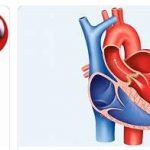In the case of mitral valve insufficiency, the heart valve located between the left atrium and left ventricle is no longer able to close completely. With an incidence of about 2 to 3 percent, mitral valve regurgitation is the second most common valve defect in adulthood.
What is mitral valve regurgitation?
Mitral valve insufficiency occurs when the sealing function of the heart valve, which is located between the left atrium (atrium cordis) and the left ventricle (ventriculus cordis), is so reduced that during the heartbeat, blood partially flows back from the ventricle into the atrium (Regurgitation). See ablogtophone for JMML which stands for Juvenile Myelomonocyte Leukemia.
As a result, a certain amount of blood constantly shuttles back and forth between the left atrium and ventricle (pendulum volume), with a pendulum volume of 15 percent of the stroke volume being considered relevant mitral valve insufficiency. As a result of this constant oscillating movement of the blood, the ventricles and atrium increasingly expand (dilation), while the left ventricle is simultaneously increasingly restricted in its capacity (left heart failure).
The increased blood volume in the left atrium can cause blood to back up in the lungs. In the long term, the increased blood pressure there (pulmonary hypertension) means that the water in the blood is pressed into the lungs. The right ventricle is increasingly unable to supply blood to the lungs. This leads to a permanent overload and finally to right heart failure.
Cardiac arrhythmias and atrial fibrillation, blood clots in the affected atrium, reduced performance, shortness of breath and edema when the right ventricle is involved are characteristic symptoms of mitral valve insufficiency.
Causes
In most cases, mitral valve insufficiency is due to rheumatic or bacterial endocarditis.
As a result of the inflammation of the inner lining of the heart, scar tissue develops, which can cause the mitral valve to narrow and leak. In addition, rheumatic fever following a streptococcal infection can affect not only the joints and the brain but also the heart structures or the mitral valve and result in insufficiency.
In addition, mitral valve insufficiency is associated with mitral valve prolapse (malformed mitral valve apparatus), myocardial infarction (heart attacks), hypertrophic obstructive and dilated cardiomyopathy (heart muscle disease) and calcifications (calcifications) of the valve ring. Mitral valve insufficiency can also be congenital or traumatic (tear of the tendon threads).
Typical Symptoms & Signs
- cardiac arrhythmias
- palpitations and/or tachycardia
- heart murmurs
- atrial fibrillation
- thrombosis
- Low resilience
- shortness of breath
- edema
Diagnosis & History
Mitral valve insufficiency can be diagnosed by auscultation (listening) with a stethoscope based on the audible blood reflux through the affected mitral valve.
An ECG (echocardiogram) and X-rays can be used to demonstrate the characteristic changes in the heart (enlarged left atrium) and potential pulmonary edema. In addition, as part of a heart catheter examination, in which a catheter is advanced to the heart via a larger body vein under local anesthesia, the exact pendulum volume and thus the disease stage can be determined.
The prognosis and course of mitral valve insufficiency depend heavily on the severity and degree of progression of the disease. On average, about 25 to 40 percent of those affected who have not undergone surgery are alive five years after diagnosis, while the mortality rate for valve replacement decreases significantly (20-40 percent).
Complications
The mitral valve insufficiency causes serious heart problems in the patient. In the worst case, these can even lead to the death of the patient if treatment of this disease is not initiated. As a rule, those affected suffer from heart palpitations or heart palpitations.
Heart rhythm disturbances can also occur, resulting in unusual sounds in the heart. Those affected also suffer from fatigue or low resilience. Breathing difficulties can also occur, which can lead to loss of consciousness or damage to the internal organs.
If the mitral valve insufficiency is not treated, the patient’s life expectancy is significantly reduced. It is not uncommon for those affected to also suffer from depression or often from a fear of death if there is an oppressive feeling or a stabbing pain in the chest. For this reason, the quality of life is significantly restricted by mitral valve insufficiency.
The treatment of this disease depends on the symptoms and the causes. As a rule, however, a surgical intervention is necessary, which does not lead to any particular complications. Furthermore, it is usually necessary to take medication to prevent inflammation and infections.
When should you go to the doctor?
Changes and abnormalities in the heart rhythm must be presented to a doctor as soon as possible. If there is an interruption in the heart rhythm, a racing heart or a strong pounding heart, a doctor must be consulted. An audible and unfamiliar heart murmur is a cause for concern. A doctor’s visit is necessary to determine the cause of the symptoms. A decrease in the usual performance, a lower emotional and physical resilience as well as increased fatigability should be examined and treated. People who suffer from sleep disorders, feel an inner restlessness or experience a lack of concentration should have a medical check-up carried out.
In adulthood, it is also advisable to take part in the medical check-ups offered for the purpose of early detection of diseases. If shortness of breath sets in or if anxiety develops due to reduced oxygen supply, a doctor is needed. With thrombosis or the development of edema, a doctor’s visit is necessary. Irritability, mood swings and behavioral problems indicate irregularities that should be discussed with a doctor. If everyday or sporting activities can no longer be carried out, if there is reduced well-being and withdrawal from participation in social life, a visit to the doctor is recommended. Clarification of the cause is recommended so that a life-threatening condition does not develop.
Treatment & Therapy
In the case of mitral valve insufficiency, the therapeutic measures depend on the severity of the disease, although nowadays surgery is usually performed at an early stage. Mild heart failure is initially treated with medication. ACE inhibitors, among others, are used to reduce afterload.
At the same time, underlying diseases such as arterial hypertension or endocarditis, which promote the progression of the insufficiency, are treated consistently. In the case of congenital impairments of the mitral valve apparatus and pronounced mitral valve insufficiency with right heart failure and severely impaired functionality of the left ventricle, surgical intervention is usually indicated.
Standard surgical procedures are mitral valve reconstruction and replacement of the mitral valve with a mechanical or biological valve prosthesis, with valve reconstruction being used more frequently in Germany than valve replacement. The patient is connected to a heart-lung machine, while the mitral valve is reconstructed with the help of tissue and synthetic tendon threads (usually made of Goretex) and stabilized by a special support ring sewn onto the mitral valve.
If the mitral valve cannot be repaired, it is replaced with a prosthetic valve made of synthetic (pyrolytic carbon, stainless steel housing) or biological (bovine or porcine tissue) material. In addition, to avoid blood clots in the enlarged left atrium, blood coagulation is inhibited with medication (including phenprocoumon, warfarin).
In the case of mitral valve insufficiency, antibiotic therapy is always used prophylactically to avoid bacterial infection and thus additional damage to the valve if there is an increased risk of infection (including dental interventions).
Outlook & Forecast
Due to the very individual and different course of mitral valve insufficiency, the prognosis for patients is also relatively different. Nowadays, however, it is assumed that patients who suffer from only mild mitral valve insufficiency and otherwise have no other heart diseases can have a completely normal life expectancy.
Patients diagnosed with an indication for surgery according to current guidelines have seen an 89 percent survival rate over eight years. Studies from 1980 to 1989 show a dependency on the prognosis of the pumping capacity of the left ventricle as it was before the operation.
Here the survival rate of patients with a more normal ventricular function, the so-called ejection fraction of over 60 percent, for 10 years is around 72 percent. This corresponds to a survival rate of people of the same age without heart surgery. Meanwhile, the survival rate of those affected with an ejection fraction of less than 50 percent is significantly lower at 32 percent.
Sudden deaths in those affected with mitral regurgitation are quite rare. Because they only occur in patients with an extremely low frequency of just under 0.8 percent. However, if those affected also have other heart diseases such as atrial fibrillation, sudden death can occur with a higher probability of around 4.8 percent.
Prevention
Mitral valve insufficiency can be prevented by consistently treating bacterial infections and other triggering underlying diseases in order to reduce the risk of damage to the heart valves. However, congenital mitral valve defects that lead to insufficiency cannot be prevented.
Aftercare
After surgical treatment of mitral valve insufficiency, patients usually recover relatively quickly. However, consistent follow-up care is important. The affected person should first take it easy and take special medicines. If the mitral valve insufficiency is treated by clipping, the patient has to spend the night in the intensive care unit.
There, a thorough monitoring of breathing and cardiovascular system takes place. A day later, the patient is transferred to a normal ward of the hospital, where he stays for about three to five days. During this period he is already allowed to get up and move again. It is often found in the first few days that the symptoms of mitral valve insufficiency, such as shortness of breath, have improved and that the body is more resilient again.
Follow-up care also includes taking special medication. For example, the platelet aggression inhibitor clopidogrel is administered for about a month, which prevents the platelets from clumping together. In this way, a blood clot in the arteries can be counteracted. Acetylsalicylic acid can be administered for up to six months. The drug is also an antiplatelet agent, but it has a weaker effect than clopidogrel.
For about 30 days, the patient is not allowed to lift or carry heavy loads. However, light physical endurance training, which can take place in a heart sports group under medical supervision, is definitely possible.
You can do that yourself
In the case of mild to moderate insufficiency of the mitral valve, situations that lead to a sudden increase in blood pressure or to a sudden increase in peak loads in physical performance requirements should be avoided in everyday life. A sudden increase in blood pressure due to an adrenaline rush from the sympathetic nervous system leads to an uncontrollable pressure load on the two leaflets of the mitral valve, so that the leaflets can bulge into the atrium during systole, which increases blood flow back into the left atrium.
Endurance sports such as jogging, cycling or swimming contribute to improving your own well-being. However, the sport should not be practiced up to the respective performance limit. Those affected benefit most from a relatively even load. The individual resilience can vary greatly depending on the manifestation and severity of the valve insufficiency. The top priority is by no means rest and by no means no sport, but self-help in everyday life consists in adapted processes with as few unpredictable stress peaks as possible, but definitely with moderate stress.
Mental relaxation techniques such as yoga and meditation are also well suited to support any drug treatment with beta blockers and ACE inhibitors. It is helpful to pay a little attention to physical symptoms in everyday life without being fixated on them.




